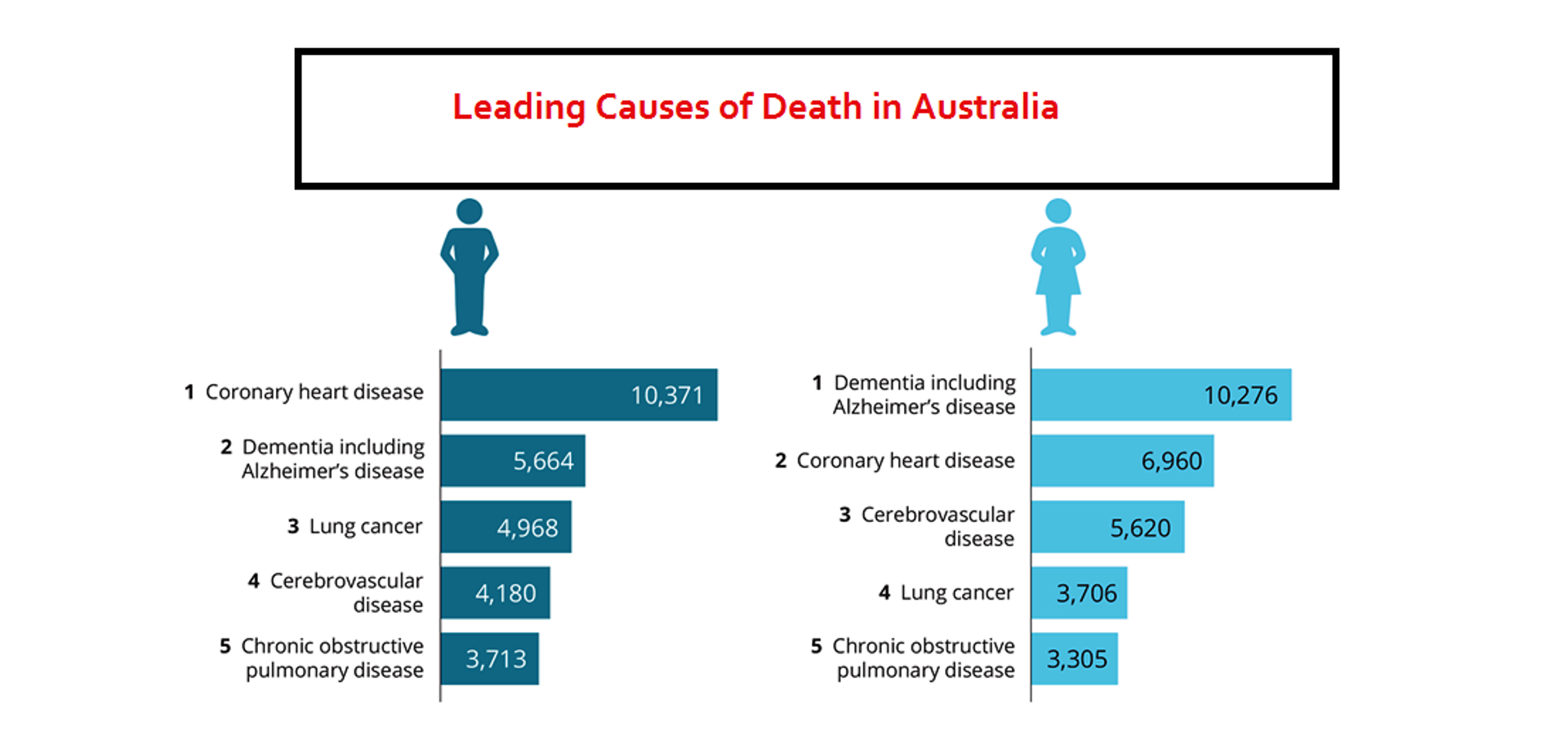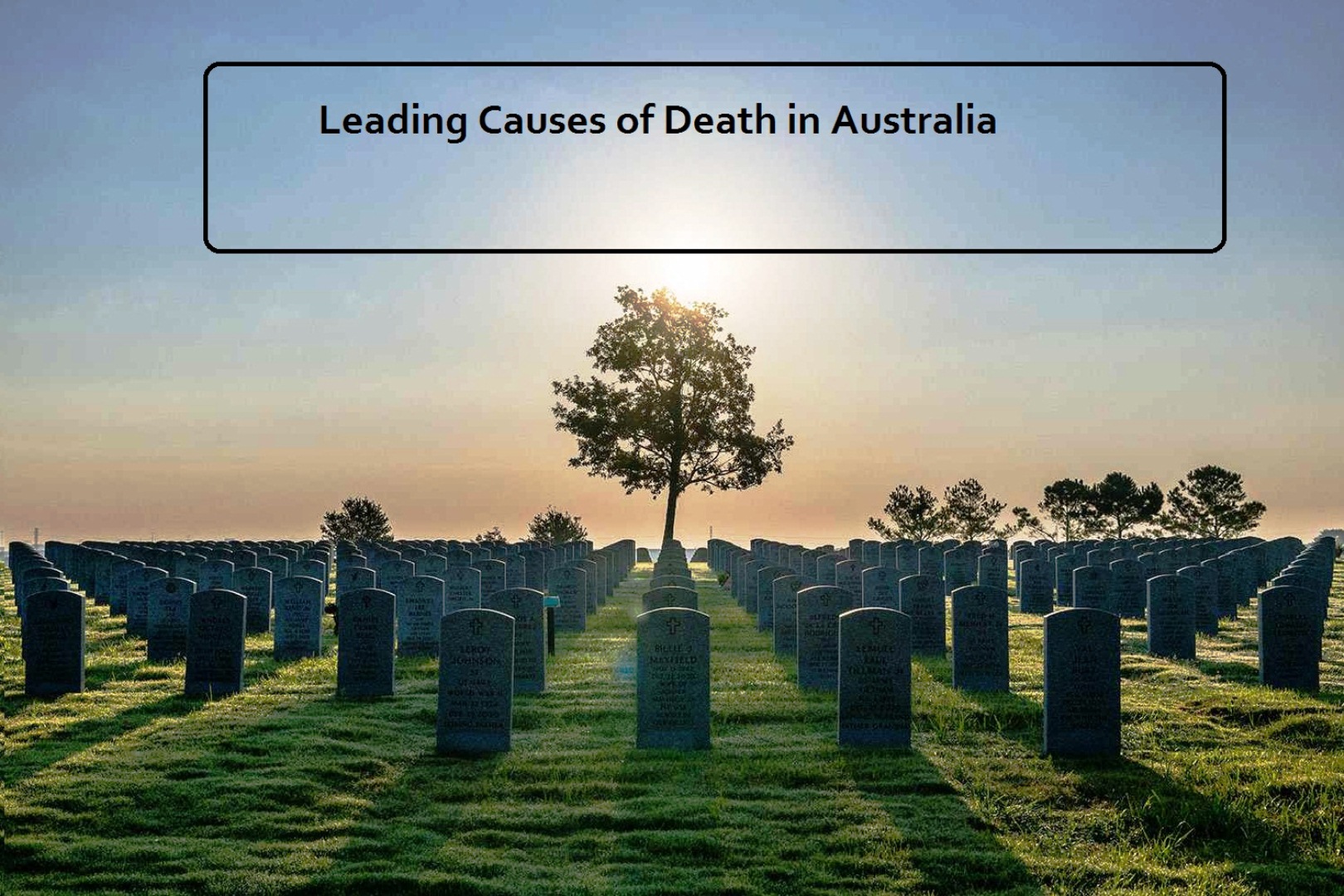Leading Causes of Death in Australia
Leading Causes of Death in Australia– In the intricate tapestry of mortality statistics, Australia’s landscape showcases a nuanced panorama of prevalent causes of death across different age groups. A closer examination of these patterns unveils a compelling narrative, shedding light on the dominance of specific ailments in various stages of life. Let us delve into the insights presented by these statistics that Causes of Death in Australia.
Ages 45–64: Coronary Heart Disease Claims the Helm
- Coronary Heart Disease: The Relentless Foe Within the age group of 45–64, one leading cause of death stands tall – coronary heart disease. This formidable ailment was responsible for reshaping lives, accounting for a significant portion of mortality. Its impact underscores the necessity of adopting heart-healthy lifestyles and interventions to curb its devastating toll.
Ages 65–74: The Dual Dance of Lung Cancer and Coronary Heart Disease
- Lung Cancer: A Surprising Vanguard As individuals transition into the age bracket of 65–74, a shift in the leading cause of death is observed. Lung cancer takes center stage, becoming the primary concern. This shift prompts a renewed focus on combating the risks associated with this prevalent cancer, often linked to tobacco use.
- Coronary Heart Disease: Looming in Second Place Despite lung cancer’s ascendancy, coronary heart disease remains a looming threat in this age group. The dynamic interplay between these two significant causes of death underscores the complexity of health challenges faced by individuals in their later years.
Ages 75–84: A Continuation of Coronary Heart Disease Dominance in Australia
- Coronary Heart Disease: Persevering as the Principal Menace The narrative remains consistent as individuals enter the age range of 75–84. Once again, coronary heart disease asserts its authority as the leading cause of death. This age group’s susceptibility to this ailment underscores the need for comprehensive health management and preventive measures.
Ages 85 and Over: The Triumph of Dementia including Alzheimer’s Disease
- Dementia including Alzheimer’s Disease: A Formidable Front runner With the passage of time and increasing age, dementia including Alzheimer’s disease takes precedence. For those aged 85 and over, this ailment emerges as the primary cause of death. The complexities of addressing cognitive decline and ensuring quality of life for the elderly population gain paramount importance.
- Coronary Heart Disease: A Pervasive Adversary Even in this advanced age group, coronary heart disease continues to hold its ground, marking its presence as the second most prevalent cause of death. Its tenacity throughout the aging process emphasizes the need for lifelong vigilance and intervention.
In the vast expanse of Australia’s mortality landscape, the dominance of specific Causes of Death in Australia across different age groups is evident. Whether it’s the persistent shadow of coronary heart disease, the unexpected rise of lung cancer, or the poignant reality of dementia including Alzheimer’s disease, these insights call for tailored interventions and comprehensive healthcare strategies. The statistics serve as a clarion call to prioritize research, awareness, and measures that can shape healthier and more resilient communities across the nation.
Leading Causes of Death in Australia Males:
- Coronary Heart Disease: A Dominant Menace Coronary heart disease stood firm as the primary cause of death among males, exacting a toll of 10,371 lives. This accounted for 12% of all male deaths in the year.
- Dementia including Alzheimer’s Disease: A Substantial Struggle Ranking second among male mortality causes, dementia including Alzheimer’s disease claimed 5,664 lives. This represented 6.3% of male deaths, revealing the pressing need for further research and support in this area.
- Cerebrovascular Disease (Stroke): A Silent Threat In the realm of cerebrovascular diseases, stroke emerged as a significant contributor to male mortality. While not the leading cause, it was among the top 5, reflecting the importance of preventive measures.
- Lung Cancer: A Gender-Neutral Challenge Lung cancer’s presence was prominent in male mortality statistics, emphasizing the need for continued efforts in raising awareness about its causes and implementing measures to combat its impact.
- Chronic Obstructive Pulmonary Disease (COPD): A Looming Shadow Chronic obstructive pulmonary disease secured its place as the fifth leading cause of male deaths. It highlighted the necessity of addressing lifestyle and environmental factors that contribute to this ailment.
Leading Causes of Death in Australia Females:
- Dementia including Alzheimer’s Disease: A Distinct Female Concern Dementia including Alzheimer’s disease assumed the grim mantle of the leading cause of death among females, resulting in 10,276 deaths. This accounted for 13% of all female deaths in the year.
- Coronary Heart Disease: Posing a Formidable Challenge Following closely, coronary heart disease claimed the lives of 6,960 females, representing 8% of female deaths. This reinforced the need for gender-specific approaches to combat heart disease.
- Cerebrovascular Disease (Stroke): A Common Ground As in the case of males, stroke was a significant cause of death among females. It demonstrated the importance of addressing risk factors that transcend gender lines.ReferenceBecker R, Silvi J, Ma Fat D, L’Hours A and Laurenti R (2006). A method for deriving leading causes of death. Bulletin of the World Health Organization, 84(4), 297–304.Other Diseases and Leading Causes of Death in Australia
In the complex tapestry of mortality statistics, Australia’s health landscape paints a vivid picture of the diverse array of diseases that shape the course of life. Beyond the well-known adversaries, a closer examination reveals a host of other diseases contributing significantly to the country’s mortality statistics. Here, we delve into these often-overlooked contributors and their impact on the nation’s health.
Diabetes: A Silent Intruder in the Ranks and Leading Causes of Death in Australia
- Diabetes Causes of Death in Australia : A Stealthy Challenger While not often in the spotlight, diabetes stands as a formidable opponent on the stage of mortality in Australia. In 2021, it claimed the lives of 5,404 individuals, securing its place as the 7th leading cause of death. This ranking, consistently held for several years, underlines the persistent challenges posed by this chronic condition.Cancers That Leave Their Mark
- Colorectal Cancer Causes of Death in Australia : A Substantial Threat Among the various cancers that cast their shadow, colorectal cancer emerges as a noteworthy adversary, ranking 6th in the list of leading causes of death. Its impact underscores the importance of early detection and comprehensive cancer care.
- Cancers of Blood or Lymphatic System, Prostate, Pancreas, Breast, and Liver Causes of Death in Australia : A Varied Landscape The realm of cancer is diverse, and the statistics reflect this diversity. Cancers of the blood or lymphatic system, prostate, pancreas, breast, and liver all contribute to Australia’s mortality tapestry. Their positions in the ranking (ranging from 8th to 19th) serve as a reminder of the multifaceted nature of cancer’s impact on the nation.
Liver Health and Parkinson’s: A Silent Struggle
- Cirrhosis and Other Diseases of the Liver: Lurking in the Shadows Liver health takes center stage as cirrhosis and other diseases of the liver secure the 18th spot in the leading causes of death. This serves as a call to address lifestyle factors and promote awareness around liver health.
- Parkinson’s Disease: An Underrated Challenge Parkinson’s disease, while often overshadowed by more prominent adversaries, takes the 20th place. Its presence highlights the importance of continued research, support, and care for individuals battling this neuro degenerative disorder.
Shifting Tides: Accidental Falls and Influenza
- Accidental Falls: An Alarming Surge The unassuming threat of accidental falls has been on the rise, climbing from 16th place in 2016 to 10th in 2021. Responsible for 3,747 deaths, this statistic is a stark reminder of the need for enhanced safety measures, especially among the elderly population.
- Influenza and Pneumonia: A Changing Landscape The landscape of influenza and pneumonia’s impact on mortality shifted from 17th place in 2020 to 22nd in 2021. While only a small number of deaths were directly attributed to the flu, these ailments continue to affect vulnerable populations, emphasizing the need for vaccination and preventive measures.
In the grand tableau of Australia’s health challenges, these often-overlooked diseases and causes of death play a significant role. As the nation navigates the intricacies of healthcare, a holistic approach that addresses both well-known adversaries and these underappreciated contributors is essential to fostering a healthier and more resilient society.
- Diabetes Causes of Death in Australia : A Stealthy Challenger While not often in the spotlight, diabetes stands as a formidable opponent on the stage of mortality in Australia. In 2021, it claimed the lives of 5,404 individuals, securing its place as the 7th leading cause of death. This ranking, consistently held for several years, underlines the persistent challenges posed by this chronic condition.Cancers That Leave Their Mark
- The leading causes of death in Australia are influenced by various factors including lifestyle, medical advancements, and demographic changes. Here’s a detailed look at the major causes:
- 1. Coronary Heart Disease
- Coronary heart disease (CHD) is the leading cause of death in Australia. It occurs when the coronary arteries, which supply blood to the heart muscle, become narrowed or blocked due to the build-up of plaque. This can lead to chest pain (angina), heart attacks, and other cardiovascular complications.
- Risk Factors: Smoking, high blood pressure, high cholesterol, obesity, physical inactivity, diabetes, and family history.
- Prevention: Healthy diet, regular exercise, quitting smoking, controlling blood pressure and cholesterol, and managing diabetes.
- 2. Dementia, including Alzheimer’s Disease
- Dementia is a broad category of brain diseases that cause long-term and often gradual decrease in the ability to think and remember. Alzheimer’s disease is the most common form of dementia.
- Risk Factors: Age, family history, genetic factors, lifestyle factors (diet, exercise), cardiovascular health.
- Prevention and Management: While there is no cure, a healthy lifestyle, mental and social engagement, and managing cardiovascular risk factors may help reduce the risk or delay onset.
- 3. Cerebrovascular Disease (Stroke)
- Cerebrovascular disease includes conditions caused by problems with the blood vessels that supply the brain. Stroke is the most common form, occurring when blood flow to a part of the brain is cut off.
- Risk Factors: High blood pressure, high cholesterol, smoking, diabetes, obesity, heart disease.
- Prevention: Healthy lifestyle choices, managing blood pressure, controlling diabetes, avoiding smoking, and recognizing early signs of stroke.
- 4. Lung Cancer
- Lung cancer is one of the most common cancers in Australia and a leading cause of cancer death. It is primarily caused by smoking, although non-smokers can also develop the disease.
- Risk Factors: Smoking (primary cause), exposure to secondhand smoke, exposure to radon gas, asbestos, and other carcinogens.
- Prevention: Quitting smoking, avoiding exposure to known carcinogens, regular health screenings for high-risk individuals.
- 5. Chronic Lower Respiratory Diseases (CLRD)
- This category includes chronic obstructive pulmonary disease (COPD), emphysema, and chronic bronchitis. These diseases obstruct airflow and cause breathing problems.
- Risk Factors: Smoking, long-term exposure to lung irritants like air pollution, chemical fumes, dust, and genetic factors.
- Prevention: Quitting smoking, avoiding lung irritants, and managing symptoms through medication and lifestyle changes.
- 6. Prostate Cancer
- Prostate cancer is the most commonly diagnosed cancer in Australian men. It occurs when cells in the prostate gland grow uncontrollably.
- Risk Factors: Age, family history, genetic mutations, diet, and lifestyle.
- Prevention and Screening: Regular screening for men over 50 or earlier for those at higher risk, maintaining a healthy diet and lifestyle.
- 7. Colorectal Cancer
- Colorectal cancer affects the colon and rectum and is one of the most common cancers in Australia.
- Risk Factors: Age, family history, inflammatory bowel disease, diet high in red and processed meats, smoking, heavy alcohol use.
- Prevention: Regular screening (colonoscopy), maintaining a healthy diet rich in fruits, vegetables, and fibers, regular exercise, and avoiding smoking and excessive alcohol.
- 8. Diabetes
- Diabetes, particularly type 2 diabetes, is a growing health problem in Australia. It occurs when the body cannot properly use or produce insulin, leading to high blood sugar levels.
- Risk Factors: Obesity, physical inactivity, poor diet, family history, and age.
- Prevention and Management: Healthy diet, regular physical activity, maintaining a healthy weight, and regular monitoring of blood sugar levels.
- 9. Suicide
- Suicide is a significant cause of death, particularly among younger Australians. Mental health issues, including depression and anxiety, are major contributing factors.
- Risk Factors: Mental illness, substance abuse, family history, traumatic experiences, social isolation.
- Prevention: Mental health support, access to counseling and therapy, community support, awareness, and early intervention.
- 10. Breast Cancer
- Breast cancer is the most common cancer among Australian women and a leading cause of cancer death. It occurs when cells in the breast grow uncontrollably.
- Risk Factors: Age, family history, genetic mutations (e.g., BRCA1 and BRCA2), hormonal factors, lifestyle factors.
- Prevention and Screening: Regular mammograms, self-examinations, maintaining a healthy weight, limiting alcohol intake, and considering genetic counseling for those at high risk.
- These leading causes of death in Australia reflect a combination of lifestyle factors, genetic predispositions, and social determinants of health. Preventive measures, early detection, and effective management of chronic diseases are essential to reducing mortality rates and improving public health outcomes. Public health campaigns, healthcare access, and individual lifestyle changes play a crucial role in addressing these health challenge.
The haunting reality of the Causes of Death in Australia casts a somber shadow upon this sunburnt land. Each year, countless lives are claimed by these merciless afflictions, stealing away loved ones and shattering families with their relentless grip. Amidst this sorrowful symphony, heart disease emerges as a merciless conductor, orchestrating the demise of thousands who succumb to its silent melodies. As it relentlessly tightens its grasp on weakened hearts, stroke lurks menacingly in the shadows, ready to strike with an unforgiving blow. The icy hand of cancer reaches out indiscriminately across all corners of this vast continent, silently eradicating dreams and aspirations one life at a time. Meanwhile, respiratory diseases weave a web of suffocation around vulnerable lungs that gasp desperately for air but find none. And as mental health struggles continue to plague our nation’s soul, suicide emerges as an ever-present specter in Causes of Death in Australia an alarming testament to the profound sadness that permeates our collective consciousness. In this harsh tale etched into our land’s narrative fabric lies both grief and resiliencea reminder that amidst darkness there is always hope for light to pierce through.







